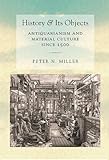History and Its Objects : Antiquarianism and Material Culture since 1500 / Peter N. Miller.
Material type: TextPublisher: Ithaca, NY : Cornell University Press, [2017]Copyright date: ©2017Description: 1 online resource (312 p.)Content type:
TextPublisher: Ithaca, NY : Cornell University Press, [2017]Copyright date: ©2017Description: 1 online resource (312 p.)Content type: - 9781501708244
- Antiquities -- Study and teaching
- Historiography
- Material culture -- History
- Material culture
- Art History
- History
- HISTORY / Historiography
- A History of the World in 100 Objects
- Antiquities
- Cultural Histories of the Material World
- Cultural history material
- Cultural history
- Historiography Material culture
- The Hare with Amber Eyes
- ancient world
- anthropologists
- antiquarian history
- antiquarianism
- archaeology
- art history
- curation studies
- europe historiography
- historiography
- history of objects
- material Cultural history
- material art history
- material culture studies
- material culture
- museum studies
- museumology
- 930.1071 23/eng/20230216
- GN406
- online - DeGruyter
| Item type | Current library | Call number | URL | Status | Notes | Barcode | |
|---|---|---|---|---|---|---|---|
 eBook
eBook
|
Biblioteca "Angelicum" Pont. Univ. S.Tommaso d'Aquino Nuvola online | online - DeGruyter (Browse shelf(Opens below)) | Online access | Not for loan (Accesso limitato) | Accesso per gli utenti autorizzati / Access for authorized users | (dgr)9781501708244 |
Browsing Biblioteca "Angelicum" Pont. Univ. S.Tommaso d'Aquino shelves, Shelving location: Nuvola online Close shelf browser (Hides shelf browser)

|

|

|

|

|

|

|
||
| online - DeGruyter Margery Kempe and the Lonely Reader / | online - DeGruyter The One Percent Solution : How Corporations Are Remaking America One State at a Time / | online - DeGruyter Dismantling Solidarity : Capitalist Politics and American Pensions since the New Deal / | online - DeGruyter History and Its Objects : Antiquarianism and Material Culture since 1500 / | online - DeGruyter Love's Wounds : Violence and the Politics of Poetry in Early Modern Europe / | online - DeGruyter The Transmission of "Beowulf" : Language, Culture, and Scribal Behavior / | online - DeGruyter The Currency of Confidence : How Economic Beliefs Shape the IMF's Relationship with Its Borrowers / |
Frontmatter -- Contents -- Illustrations -- Introduction: Why Historiography Matters -- 1. History and Things in the Twentieth Century -- 2. Karl Lamprecht and the “Material Turn” c. 1885 -- 3. Things as Historical Evidence in the Late Renaissance and Early Enlightenment -- 4. Material Evidence in the History Curriculum in Eighteenth-Century Göttingen -- 5. Archaeology as a Way of Talking about Things, 1750–1850 -- 6. Material Culture in the Amateur Historical Associations of Early Nineteenth-Century Germany -- 7. Gustav Klemm, Cultural History, and Kulturwissenschaft -- 8. The Germanisches Nationalmuseum: Antiquitates and Cultural History in the Museum -- Conclusion: Toward a Future Theory of the Historical Document -- Notes -- Bibliography -- Index
restricted access online access with authorization star
http://purl.org/coar/access_right/c_16ec
Weaving together literary and scholarly insights, History and Its Objects will prove indispensable reading for historians and cultural historians, as well as anthropologists and archeologists worldwide. — Nathan Schlanger, École nationale des chartes, ParisCultural history is increasingly informed by the history of material culture—the ways in which individuals or entire societies create and relate to objects both mundane and extraordinary—rather than on textual evidence alone. Books such as The Hare with Amber Eyes and A History of the World in 100 Objects indicate the growing popularity of this way of understanding the past. In History and Its Objects, Peter N. Miller uncovers the forgotten origins of our fascination with exploring the past through its artifacts by highlighting the role of antiquarianism—a pursuit ignored and derided by modem academic history—in grasping the significance of material culture.From the efforts of Renaissance antiquarians, who reconstructed life in the ancient world from coins, inscriptions, seals, and other detritus, to amateur historians in the nineteenth century working within burgeoning national traditions, Miller connects collecting—whether by individuals or institutions—to the professionalization of the historical profession, one which came to regard its progenitors with skepticism and disdain. The struggle to articulate the value of objects as historical evidence, then, lies at the heart both of academic history-writing and of the popular engagement with things.Ultimately, this book demonstrates that our current preoccupation with objects is far from novel and reflects a human need to reexperience the past as a physical presence.
Mode of access: Internet via World Wide Web.
In English.
Description based on online resource; title from PDF title page (publisher's Web site, viewed 26. Apr 2024)


